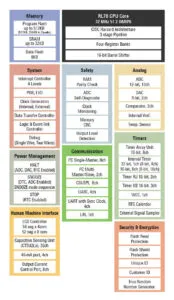The new parts are the RL78/L23 group, and have the company’s in-house RL78 low-power 16bit three-stage pipeline CISC core, running at its maximum of 32MHz.
This is supported by up to 512kbyte of flash, up to 32kbyte of ram and 8kbyte of data flash.
“The 16bit RL78 family has been one of the most successful products since its launch more than 10 years ago, particularly in home appliances,” said Renesas v-p of embedded processing Daryl Khoo”The RL78/L23 generation [is] ideally suited for smart home appliances and IoT.”
Active current is 109μA/MHz, stand-by can be for as little as 365nA, and it can wake in 1μs.
The LCD controller has the company’s VL4 ‘reference mode’ which cuts operating current by ~30% compared to its earlier RL78/L1x MCUs, and it gets the company’s recent ‘snooze mode sequencer’ block (SMS) which enables dynamic LCD segment control without CPU intervention.
“By off-loading tasks to the SMS, the devices minimise CPU wake-ups and contribute to system-level power savings,” said Renesas.
Depending on the part, between 19 and 56 LCD segments can be driven, with 4 to 8 commons.
The touch controller can support up to 36 keys in self-capacitance mode, or an 8 x 8 matrix in mutual capacitance mode.
Timers include ‘KB40’ which supports up to three channels of induction heating control for cook-tops and rice cookers.
Operation is from rails between 1.6V and 5.5V and across -40 to +105°C, and packaging is LFQFP, LQFP or HWQFN with 44 to 100 pins.
A software development environment is available which includes a IEC60730-compliant self-test library for household safety.
As well as home appliance use, battery-powered applications that spend much of their time in stand-by are envisaged, and direct operation from 5V opens up industrial use.

